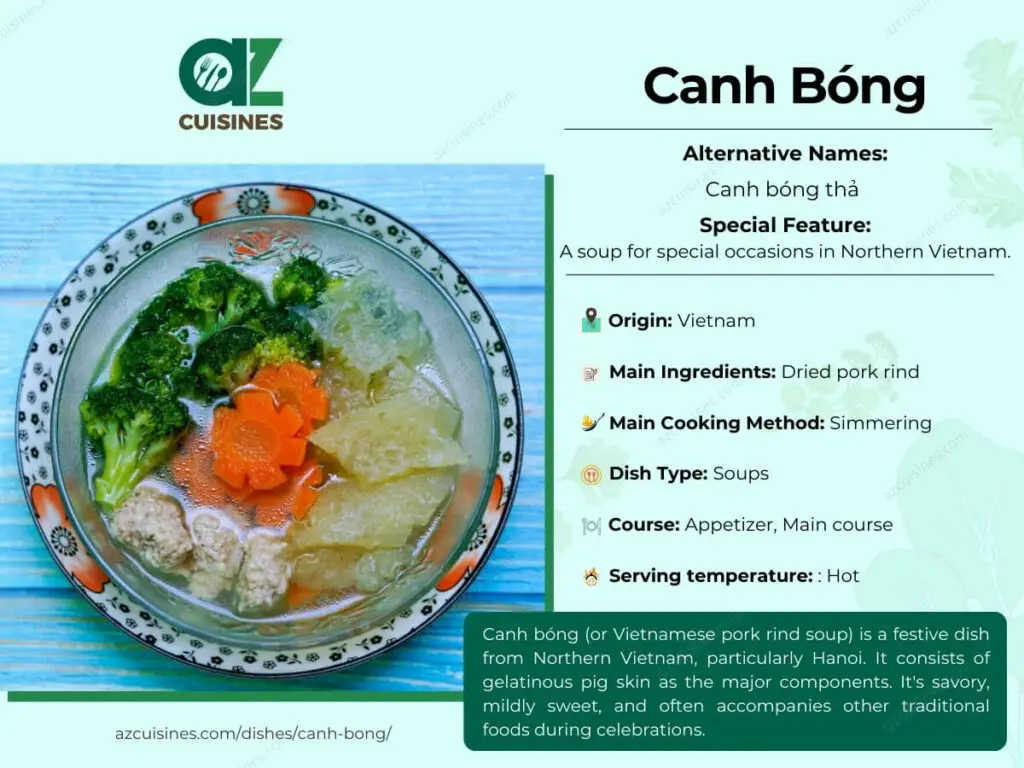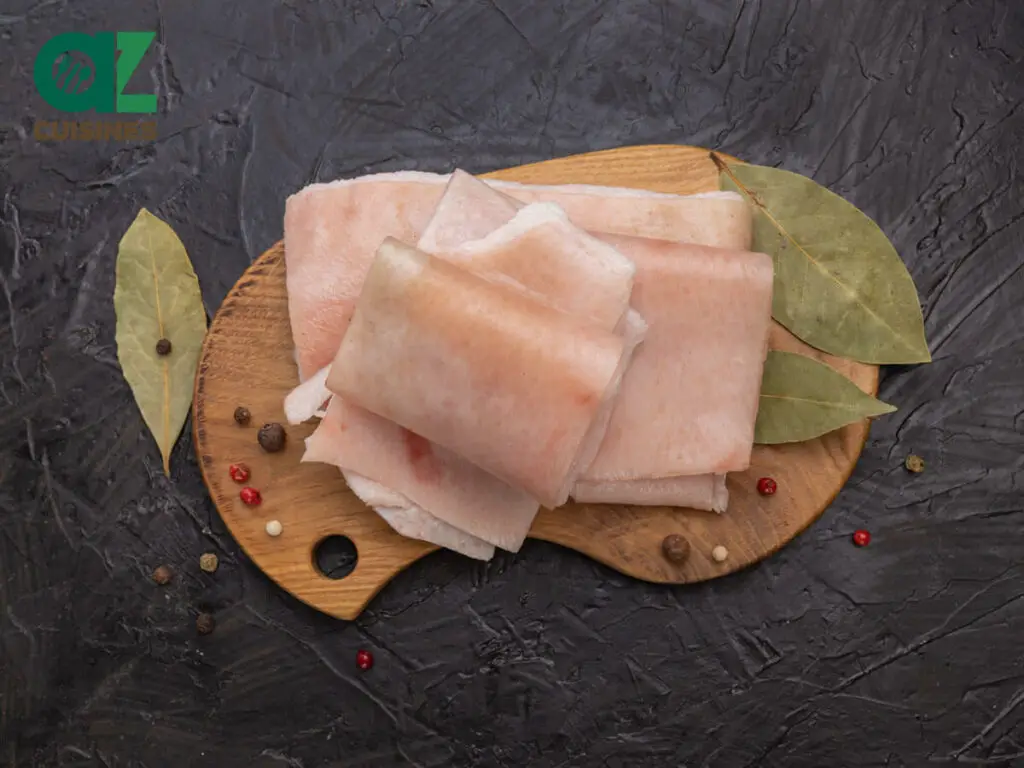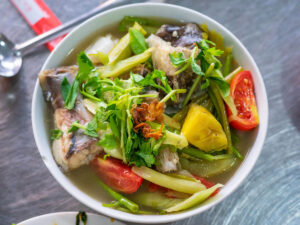#107 in Vietnam
Canh Bóng: Basic Information
Pronunciation
Alternative Name(s)
Dish Type
Course
Mealtime
Popular Variations
Canh Bóng: Ingredients and Preparation
Main Ingredients
Main Cooking Method
Preparation Process
Canh Bóng: A Deep Dive
Cultural Significance
Taste
Texture
Aroma
Color
Serving Style
Serving Temperature
Accompaniment
Occasions
Seasons
Special Diets
Calories
Popularity
Popular Similar Dishes
- Canh Khổ Qua Nhồi Thịt
- Canh Chua
Popular Dining Area
Canh bóng (Vietnamese pork rind soup) is a traditional dish served on festive tables during Lunar New Year (aka Tet), special occasions, or other communal gatherings in Northern Vietnamese cuisine, particularly in Hanoi.
As the name suggests, the soup (called “canh” in Vietnamese) includes dried pig skin as the main ingredient, which is cooked until gelatinous and floats on the surface of the soup. That’s why it is also called “canh bóng thả,” which implies the pig’s skin resembles floating bubbles on the top.
Canh bóng is not a dish; it embodies the spirit of festivity. Furthermore, it combines several ingredients, from proteins to vegetables, offering an umami, savory, and mildly sweet flavor with contrasting textures.
The pork rind soup is also served with other traditional delights on festive tables in Vietnam’s Northern region. But in the Southern part, the soup with bitter melon is more popular. There are also other similar Vietnamese soups that are worth a try.
Key Points
How Is Canh Bóng Important in Vietnamese Cuisine?
Canh bóng is a symbolic dish for Vietnam’s Lunar New Year celebration, particularly in Hanoi and other Northern areas. It is considered one of the four key dishes, including fins (called vay), bamboo shoots (mang), and glass noodles (mien), on the dining table for special occasions.
The pork rind soup represents the sophistication of Northern Vietnamese culinary traditions. The floating bubbles are often interpreted as a symbol of lightness and purity, representing the essence of spring and renewal that comes with the Lunar New Year.
In addition, raw pork skin requires meticulous preparation and a deep understanding of its ingredients and cooking techniques to show care and attention to detail. Besides the rind, you also need to prepare other components to make canh bóng.
What Are The Ingredients for Making Canh Bóng?
The star of canh bóng is pork rind. Other components like pork bone, vegetables like carrot, broccoli, kohlrabi, Vietnamese pork paste, shiitake mushroom, cilantro, garlic, ginger, seasonings like peppercorn, and fish sauce make the soup tastier.
Either using make-from-scratch or ready-made pork rind, it is important to soften the rind with water and clean it with ginger and alcohol if it still has odors. After thoroughly washing the rind with water, then use paper towels to pat the skin dry.
Locals normally cut the dried pork skin into bite-sized pieces before adding to the soup with other components, then cooking them until the other ingredients are cooked through, and the rind is floated on the top.
You can replace all meat-based components with tofu skin and add more mushrooms if you prefer a vegan version. For garnishing, add chopped green onions and cilantro before serving.
The standard (non-vegan) canh bóng is around 400 kcals, but the calories also rely on the ingredients you use and their quantities.
How To Prepare Pork Skin For Canh Bóng From Scratch?
Dried pork skin (or rind) is a core component in canh bóng. For those who want to prepare the soup from scratch, preparing the pork skin involves many steps to achieve the desired puffiness in the skin.
First, you need to scrape the skin fully, then remove any remaining layers of fat with a knife. Remember, the cleaner the scraping, the more transparent the rind will be! Then, you should soak the rind in water to soften it and add ginger and white alcohol to remove any unpleasant odor.
Wash the pork skin thoroughly multiple times for a gelatinous but not mushy texture with a pale yellow color. The skin is then sun-dried until completely dry, which allows it to become glossy after cooking.
Remember, choosing and preparing the pig’s skin properly is important to improve this Vietnamese soup with pork rind.
What Are Tips for Enhancing Canh Bóng’s Flavor and Texture?
There are 8 tips for improving the flavor and texture of canh bóng as below:
- Use high-quality, fresh pork rind.
- Use homemade broth.
- Toast spices (like peppercorn) before adding them to broth.
- Add a few slices of chili, if desired.
- Marinate the pork rind with fish sauce, ginger, and pepper.
- Skim off the excess fat during the cooking process.
- Cook the soup at the proper time so the pork rind is gelatinous, not too mushy.
- Stir the canh bóng soup gently when cooking and serving.
What to Serve with Canh Bóng?
Canh bóng is reserved for important occasions in Northern Vietnam and is often served alongside other celebratory dishes. Therefore, locals usually eat this soup as a separate dish.
For the best taste, you should serve the soup hot. You can also enjoy it with steamed white rice if desired.
Though canh bóng is delectable, it’s essential to consider both its advantages and disadvantages when consuming it.
Pros and Cons of Eating Canh Bóng
Canh bóng is a meaningful Vietnamese soup, but it also has some not-so-good sides to concern, which are shown in the below table.
Pros
Cons
Finally, let’s move to the FAQs part to explore more about this pork rind soup in Vietnamese cuisine.
Canh Bóng FAQs
Here are 3 commonly asked questions about Vietnamese pork rind soup








Truc Tran (Kris)
Senior Food Editor
Expertise
Home Cooking, Meal Planning, Recipe Development, Baking and Pastry, Food Editor, Cooking-video Maker, Vietnamese Food Evaluation Expert
Education
Truc Tran (Kris), an experienced food writer and editor, is great at exploring and describing global cuisines, from simple street food to fancy dining. In her writing, she skillfully mixes different flavors, cooking methods, and culinary traditions, showing the unique character of various cultures through their food and drinks. On azcuisines.com, Kris highlights her knowledge, especially in Asian cuisine and worldwide traditional dishes.